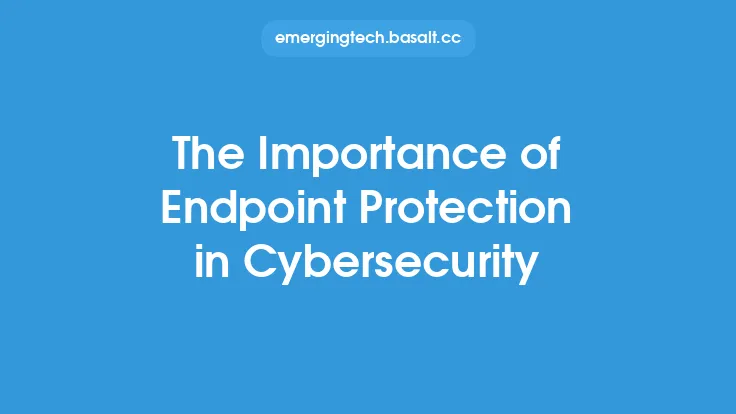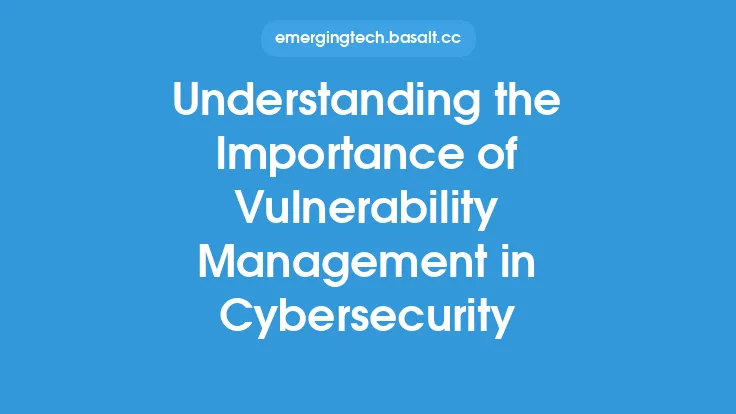In today's digital landscape, cybersecurity threats are becoming increasingly sophisticated and frequent. As a result, organizations are facing significant challenges in protecting their networks, systems, and data from cyber attacks. One crucial aspect of cybersecurity that has gained significant attention in recent years is incident response. Incident response refers to the process of responding to and managing the aftermath of a cybersecurity incident, such as a data breach, malware outbreak, or denial-of-service (DoS) attack. The importance of incident response cannot be overstated, as it plays a critical role in minimizing the impact of a cybersecurity incident and preventing future occurrences.
What is Incident Response?
Incident response is a systematic approach to managing the response to a cybersecurity incident. It involves a series of steps, including detection, containment, eradication, recovery, and post-incident activities. The primary goal of incident response is to quickly respond to a cybersecurity incident, minimize its impact, and restore normal business operations as soon as possible. Incident response involves a range of activities, including identifying the root cause of the incident, assessing the damage, and taking corrective actions to prevent similar incidents from occurring in the future.
Benefits of Incident Response
Effective incident response offers numerous benefits to organizations, including minimizing downtime, reducing the risk of data breaches, and protecting reputation. By responding quickly and effectively to a cybersecurity incident, organizations can reduce the impact of the incident and prevent it from spreading. Incident response also helps organizations to identify vulnerabilities and weaknesses in their systems and networks, which can be addressed to prevent future incidents. Additionally, incident response demonstrates an organization's commitment to cybersecurity and data protection, which can enhance customer trust and confidence.
Key Components of Incident Response
Incident response involves several key components, including incident detection, incident classification, incident reporting, incident containment, incident eradication, and incident recovery. Incident detection involves identifying potential security incidents, such as unusual network activity or suspicious system behavior. Incident classification involves categorizing the incident based on its severity and impact. Incident reporting involves notifying stakeholders, including management, customers, and regulatory bodies, of the incident. Incident containment involves taking steps to prevent the incident from spreading, such as isolating affected systems or networks. Incident eradication involves removing the root cause of the incident, such as deleting malware or closing vulnerabilities. Incident recovery involves restoring normal business operations and ensuring that systems and networks are secure and functional.
Incident Response Team
An incident response team (IRT) is a critical component of an organization's incident response capabilities. The IRT is responsible for responding to and managing cybersecurity incidents, and typically consists of a team of experts with a range of skills and expertise, including technical, communications, and management skills. The IRT should have a clear understanding of the organization's incident response plan and procedures, as well as the skills and expertise to respond effectively to a range of cybersecurity incidents. The IRT should also have the authority to make decisions and take actions quickly in response to a cybersecurity incident.
Incident Response Plan
An incident response plan is a detailed document that outlines the procedures and protocols for responding to a cybersecurity incident. The plan should include information on incident detection, incident classification, incident reporting, incident containment, incident eradication, and incident recovery. The plan should also include information on the roles and responsibilities of the IRT, as well as the procedures for communicating with stakeholders and managing the incident. The incident response plan should be regularly reviewed and updated to ensure that it remains effective and relevant.
Technical Aspects of Incident Response
Incident response involves a range of technical aspects, including network monitoring, system logging, and malware analysis. Network monitoring involves using tools and techniques to monitor network activity and identify potential security incidents. System logging involves collecting and analyzing log data from systems and networks to identify potential security incidents. Malware analysis involves analyzing malware samples to understand their behavior and impact. Incident response also involves using a range of technical tools, including intrusion detection systems, firewalls, and encryption technologies.
Challenges of Incident Response
Incident response poses several challenges, including the increasing sophistication of cybersecurity threats, the lack of skilled incident response professionals, and the need for effective communication and collaboration. The increasing sophistication of cybersecurity threats means that incident response teams must be able to respond quickly and effectively to a range of complex and evolving threats. The lack of skilled incident response professionals means that organizations may struggle to find the expertise and resources needed to respond effectively to cybersecurity incidents. Effective communication and collaboration are critical to incident response, as they enable incident response teams to work effectively with stakeholders and respond quickly to cybersecurity incidents.
Best Practices for Incident Response
Several best practices can help organizations to improve their incident response capabilities, including developing a comprehensive incident response plan, establishing an incident response team, and conducting regular incident response training and exercises. Organizations should also ensure that they have the necessary technical tools and expertise to respond effectively to cybersecurity incidents. Additionally, organizations should prioritize incident response and ensure that it is integrated into their overall cybersecurity strategy. By following these best practices, organizations can improve their incident response capabilities and reduce the risk of cybersecurity incidents.
Conclusion
In conclusion, incident response is a critical aspect of cybersecurity that plays a vital role in minimizing the impact of cybersecurity incidents and preventing future occurrences. Effective incident response involves a range of activities, including incident detection, incident classification, incident reporting, incident containment, incident eradication, and incident recovery. Organizations should prioritize incident response and ensure that they have the necessary technical tools, expertise, and resources to respond effectively to cybersecurity incidents. By developing a comprehensive incident response plan, establishing an incident response team, and conducting regular incident response training and exercises, organizations can improve their incident response capabilities and reduce the risk of cybersecurity incidents.





